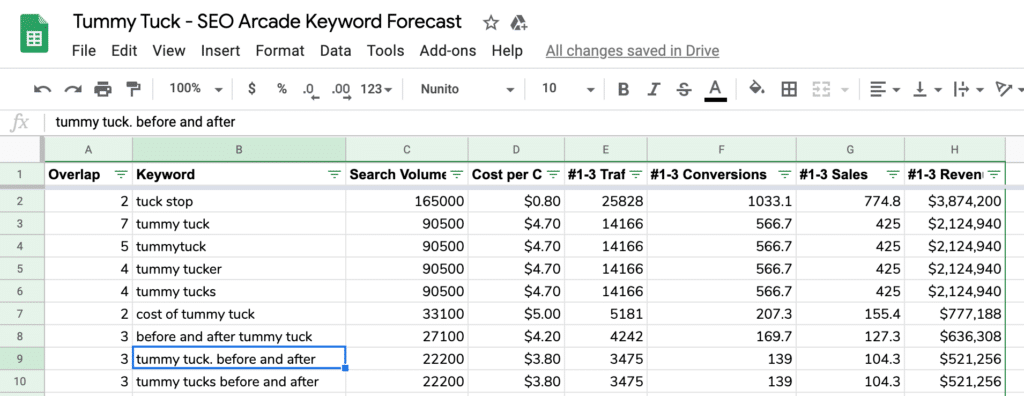We start our process by taking your keyword and seeing who currently ranks for that term. We then query all of the keywords that the URL ranks for and pull it into the sheet. The “Overlap” (in the first column) then tells you how many of those URLs also rank for that term.
This provides you insight into how Google understands that batch and cluster of keyword phrases.
PROJECTIONS AND THEIR USES
Projections per position: We mirror the Organic Click through rate study here: https://www.advancedwebranking.com/ctrstudy/ so you’re not just using “Monthly Volume” as your gauge of opportunity – but looking “into the future” to see how many visitors you could get from that volume.
But why stop there? Next, you see the conversions you could grab by ranking for a term. We then multiply that by your actual close/sale rate and revenue per sale because at the END of the day, your clients want to see the REVENUE!

Using SEo Forecasts To Understand Marketplace Potential
SEOs are so flooded with data, they don’t realize how many advantages they have when it comes to understanding the “market potential” for a product or service. For example, if you are looking for ideas for a SAAS tool, you could use an SEO forecast to see how much organic traffic, conversions (free trials), sales (paid conversions), and revenue are possible for a set of relevant keywords:

Use Overlap To Filter Out Brand Terms OR For good “Longtail Terms”
If you’re running keywords then you likely will get 1 off keyword in the top ranking that match just ONE of those URLs. These terms could be then brand-specific terms or they could hold “longtail” keywords that just 1 URL captured.
Filter the keywords to sort by highest overlap to find highly relevant keywords
Obviously, if several urls ranking for a current term also rank for additional terms, then Google likely finds them strongly related. So sorting by overlap can help sort the phrases by those that are most relevant (But obviously also have more competition.)
SEO Action items To Handle Once You Have Your Keyword Research Report
- Filter out the keywords you don’t want, and send the remaining keywords as a forecast to a client showing just how much return they’d get on their investment of time/energy/budget in SEO.
- You could also use it to convince a CEO or manager in your in-house position to get more time or budget allocated to SEO.
- Of course, if it’s for your own project you can then put it into practice and know just how much you can make from your efforts.
- Review high-value keywords and ensure they’re used on-page in headers, text, image file names, image alt text, and internal links.
- While working on your link-building process, try to acquire SAAS backlinks that have the highest value anchor text if possible in an organic manner.
Have fun with your keyword forecast, and be sure to drop a line if you have suggestions or enhancements you’d like to request!
Other SEO Uses Cases
Data is powerful. The same set of numbers, used by another person for another need presented to a different audience has a different impact. Here are some other uses cases for our report:

